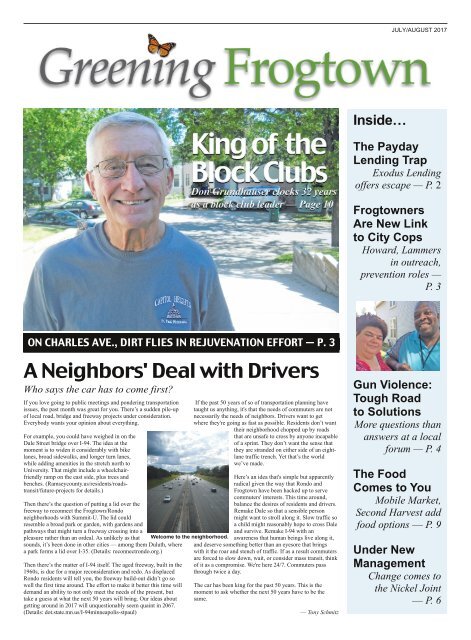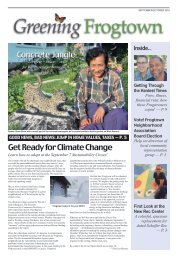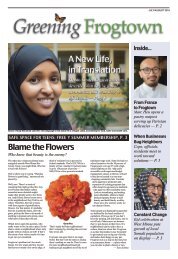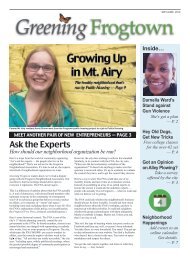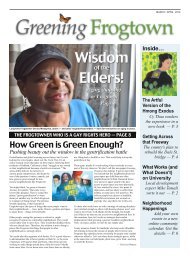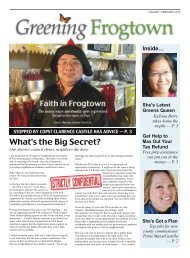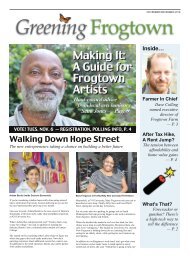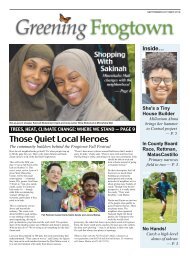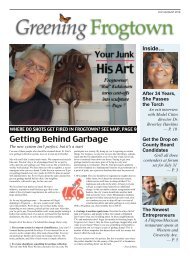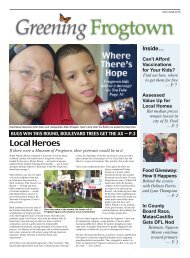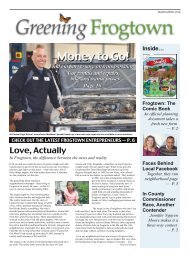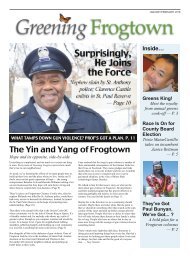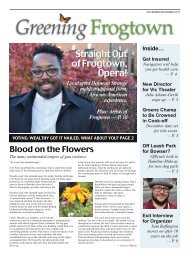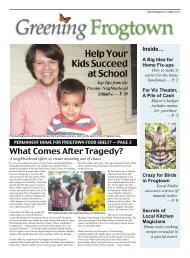GreeningFrogtownJulyAug17
You also want an ePaper? Increase the reach of your titles
YUMPU automatically turns print PDFs into web optimized ePapers that Google loves.
JULY/AUGUST 2017<br />
Inside…<br />
The Payday<br />
Lending Trap<br />
Exodus Lending<br />
offers escape — P. 2<br />
Frogtowners<br />
Are New Link<br />
to City Cops<br />
Howard, Lammers<br />
in outreach,<br />
prevention roles —<br />
P. 3<br />
ON CHARLES AVE., DIRT FLIES IN REJUVENATION EFFORT — P. 3<br />
A Neighbors' Deal with Drivers<br />
Who says the car has to come first?<br />
If you love going to public meetings and pondering transportation<br />
issues, the past month was great for you. There’s a sudden pile-up<br />
of local road, bridge and freeway projects under consideration.<br />
Everybody wants your opinion about everything.<br />
For example, you could have weighed in on the<br />
Dale Street bridge over I-94. The idea at the<br />
moment is to widen it considerably with bike<br />
lanes, broad sidewalks, and longer turn lanes,<br />
while adding amenities in the stretch north to<br />
University. That might include a wheelchairfriendly<br />
ramp on the east side, plus trees and<br />
benches. (Ramseycounty.us/residents/roadstransit/future-projects<br />
for details.)<br />
Then there’s the question of putting a lid over the<br />
freeway to reconnect the Frogtown/Rondo<br />
neighborhoods with Summit-U. The lid could<br />
resemble a broad park or garden, with gardens and<br />
pathways that might turn a freeway crossing into a<br />
pleasure rather than an ordeal. As unlikely as that<br />
sounds, it’s been done in other cities — among them Duluth, where<br />
a park forms a lid over I-35. (Details: reconnectrondo.org.)<br />
Then there’s the matter of I-94 itself. The aged freeway, built in the<br />
1 960s, is due for a major reconsideration and redo. As displaced<br />
Rondo residents will tell you, the freeway build-out didn’t go so<br />
well the first time around. The effort to make it better this time will<br />
demand an ability to not only meet the needs of the present, but<br />
take a guess at what the next 50 years will bring. Our ideas about<br />
getting around in 201 7 will unquestionably seem quaint in 2067.<br />
(Details: dot.state.mn.us/I-94minneapolis-stpaul)<br />
Welcome to the neighborhood.<br />
If the past 50 years of so of transportation planning have<br />
taught us anything, it's that the needs of commuters are not<br />
necessarily the needs of neighbors. Drivers want to get<br />
where they're going as fast as possible. Residents don’t want<br />
their neighborhood chopped up by roads<br />
that are unsafe to cross by anyone incapable<br />
of a sprint. They don’t want the sense that<br />
they are stranded on either side of an eightlane<br />
traffic trench. Yet that’s the world<br />
we’ve made.<br />
Here’s an idea that's simple but apparently<br />
radical given the way that Rondo and<br />
Frogtown have been hacked up to serve<br />
commuters' interests. This time around,<br />
balance the desires of residents and drivers.<br />
Remake Dale so that a sensible person<br />
might want to stroll along it. Slow traffic so<br />
a child might reasonably hope to cross Dale<br />
and survive. Remake I-94 with an<br />
awareness that human beings live along it,<br />
and deserve something better than an eyesore that brings<br />
with it the roar and stench of traffic. If as a result commuters<br />
are forced to slow down, wait, or consider mass transit, think<br />
of it as a compromise. We're here 24/7. Commuters pass<br />
through twice a day.<br />
The car has been king for the past 50 years. This is the<br />
moment to ask whether the next 50 years have to be the<br />
same.<br />
— Tony Schmitz<br />
Gun Violence:<br />
Tough Road<br />
to Solutions<br />
More questions than<br />
answers at a local<br />
forum — P. 4<br />
The Food<br />
Comes to You<br />
Mobile Market,<br />
Second Harvest add<br />
food options — P. 9<br />
Under New<br />
Management<br />
Change comes to<br />
the Nickel Joint<br />
— P. 6
WEALTHIFICATION<br />
A Path Out of the Payday Lending Trap<br />
Exodus Lending buys out loans, cuts interest costs to zero<br />
David Bayliss had a problem that will<br />
seem all too familiar to some<br />
Frogtowners. He had a decent job that<br />
paid the bills. Then he got laid off in<br />
November, 201 4.<br />
Unemployment payments lasted for six<br />
months. While it was a help, the amount<br />
didn’t match his previous income. He was<br />
falling behind on his bills, which were<br />
considerable. He had to cover rent, a car<br />
payment, support for his former wife and<br />
children, plus food and all the rest of life’s<br />
incidentals.<br />
He got behind on rent, behind on car<br />
payments, and was paying utilities<br />
intermittently. When he finally found<br />
another job in June of 201 5, his problems<br />
didn’t really end. His pay wasn’t enough<br />
to allow him to stay current on his bills,<br />
plus catch up with all that he owed.<br />
Bayliss’s next move was to do what 1 2<br />
million Americans do every year. He took<br />
out a payday loan.<br />
He knew it wasn’t the best move. But it<br />
was the only one he felt he had left. “You<br />
take out a payday loan because you<br />
absolutely need it,” he said. “You’re at a<br />
David Bayliss escaped the payday lending trap with help from Exodus Lending.<br />
point where you’re willing to sign up for<br />
anything. It’s the step right before being<br />
out on the street.”<br />
To get a payday loan, as too many<br />
Frogtown residents may already know,<br />
you need to have a job and a bank<br />
account. The loan limit is $350 at some<br />
shops, and $500 or more at others. You’ve<br />
got to pay the amount back in full on your<br />
next payday, plus fees and interest. On a<br />
$500 loan, the fees and interest can run to<br />
more than $33. If this were a conventional<br />
loan, the annual percentage rate (APR)<br />
would be 1 63 percent. But fees for<br />
smaller amounts are an even worse deal.<br />
Borrow just $200 and the annual<br />
percentage rate with interest and fees is<br />
365 percent.<br />
Bayliss took out his first payday loan via<br />
an online operation in August, 201 5.<br />
When it came due he didn’t have the<br />
money to pay it off. He did what many<br />
people do to satisfy his payday loan. He<br />
took out another payday loan to pay off<br />
the first one. Again he paid the fees and<br />
interest that added up, in his case, to an<br />
APR of 578 percent. For Bayliss, history<br />
repeated itself every two weeks, when his<br />
loan came due and he paid fees and<br />
interest to get another loan.<br />
He tried going to his bank for a small<br />
loan to close the gap, but quickly got an<br />
education in current banking practice.<br />
Most banks aren’t set up to provide small<br />
loans for living expenses. If you’ve had a<br />
bankruptcy in the past 1 0 years, which<br />
was the case for Bayliss, you’re way out<br />
of luck. The bank officer was<br />
sympathetic, but didn’t have anything to<br />
offer. She suggested that Bayliss hunt<br />
around for a non-profit that might be able<br />
to help.<br />
— Continued, Page 11<br />
PAGE 2 JULY/AUGUST / 2017<br />
6
Paint and Dirt Flies as Charles Avenue<br />
Rejuvenation Project Gets Underway<br />
If you drove past the 500 block of Charles<br />
Avenue on June 1 0, you saw a bustle of<br />
activity as a group of neighbors and local<br />
organizations started on an experiment to<br />
transform the block.<br />
Most times, the work on neighborhood<br />
revitalization goes something like this: A<br />
nonprofit group builds or rehabs a house<br />
on a block. There’s one spruced up<br />
property, but the rest of the block remains<br />
the same. This time around, the idea was<br />
different. A collaboration of<br />
organizations, including Habitat for<br />
Humanity, NeighborWorks Home<br />
Partners, Preserve Frogtown and the<br />
Frogtown Neighborhood Association got<br />
together to ask neighbors how they<br />
wanted their block to change, and then put<br />
together a plan to make it happen.<br />
Shovels hit the dirt on a Saturday<br />
morning, as about 50 volunteers from<br />
Habitat, the African American men’s<br />
group Ujamaa Place, NeighborWorks,<br />
Youth Farm and Thrivent Financial joined<br />
a collection of neighbors to start in on<br />
rejuvenating the block. Among the<br />
projects: 1 0 new flower and vegetable<br />
gardens with fresh, rich compost; a<br />
patched-up garage with new siding and<br />
paint; a bright accent of paint on a front<br />
porch; a new door and stoop; a new<br />
window; and a start on a new roof.<br />
FROGTOWN NEWS<br />
The block is recognized as a remarkably<br />
intact collection of turn-of-the-century<br />
workers’ cottages — small, modest homes<br />
not so much notable for their high style as<br />
for being a preserved stretch of housing<br />
that speaks to the accomplishments of the<br />
common man.<br />
“This wasn’t the end. It was the kick off, a<br />
beginning,” said Amanda Welliver at<br />
NeighborWorks after the 9 am to 3 pm<br />
project wrapped up. “This was a really<br />
good learning process for both the<br />
organizations and the neighbors."<br />
She noted that participation from<br />
neighbors grew as the Saturday event<br />
drew closer. At first only three neighbors<br />
wanted help planting a garden. “We<br />
developed a lot of new relationships. We<br />
had neighbors talking who hadn’t talked<br />
together over decades of living on the<br />
block. They were working together,<br />
talking about holding pot lucks.”<br />
"We did a good job, and everybody was<br />
helping out," said Steve Fagerland. "With<br />
all the new planting the block will look a<br />
lot better in a couple years."<br />
From left, Shoreé Ingram, Beth Hyser and Eva Moe from NeighborWorks Home<br />
Partners were among the 60+ workers on the June 1 0 Charles Ave. kick-off.<br />
Trash System Talks<br />
Near Finish Line<br />
St Paul could be closer to a revamped<br />
trash collection system, once negotiations<br />
are finalized between the city and the 1 5<br />
collection companies that currently serve<br />
Saint Paul neighborhoods. After several<br />
marathon meetings in June, participants<br />
are closing in on agreement over a new<br />
system that will be acceptable to both<br />
haulers and city officials, reports Kris<br />
Hageman, the city's Recycling and Solid<br />
Waste Program Manager.<br />
Organized trash collection advocates have<br />
espoused a system that divides the city<br />
into zones assigned to different haulers,<br />
instead of the current system that results<br />
in multiple haulers covering the same<br />
area. A new system could make<br />
provisions for hauling bulky items like<br />
mattresses and appliances, which now<br />
often end up littering Frogtown alleys.<br />
Details of the proposal are still being<br />
worked out, but a public hearing is set for<br />
Wed., July 1 9 at 5:30 pm in the City<br />
Council Chambers, Rm 31 0, City Hall.<br />
The Council will receive a staff update<br />
and recommendation for next steps<br />
toward implementing an organized trash<br />
collection system. Find out more at the<br />
city's "Coordinated Collection" webpage<br />
at: www.stpaul.gov/departments/publicworks/garbage/coordinated-collection.<br />
Patty Lammers and Johnny Howard are newly hired to serve in crime prevention<br />
and community engagement roles with the St. Paul Police Department.<br />
Frogtowners Are Link to St. Paul Cops<br />
The St. Paul Police Department added<br />
two new Frogtown-friendly staff<br />
members, bringing onboard long-time<br />
neighborhood resident and organizer<br />
Johnny Howard as community<br />
engagement specialist and outreach<br />
coordinator to the African American<br />
community, and native Frogtowner Patty<br />
Lammers as crime prevention coordinator.<br />
Howard led the Thomas Dale Block Clubs<br />
from 1 991 to 2006, building it into a<br />
network of affiliated Frogtown block<br />
clubs during a troubled period in<br />
neighborhood history. In addition to<br />
block-by-block organizing, the group ran<br />
a lawn service that employed local<br />
people, youth programs and food<br />
distribution services. Howard was also the<br />
director of West Minne’s youth football<br />
program for 1 8 years, coaching about 1 00<br />
kids each season, and has served on the<br />
boards of organizations such as the<br />
NAACP, the Urban League and the<br />
African American Leadership Council.<br />
Lammers, who has since migrated to the<br />
North End, grew up in Frogtown and, like<br />
Howard, is a familiar figure. She served<br />
on the board of the organization now<br />
known as the Frogtown Neighborhood<br />
Association for eight years, worked for<br />
the Thomas Dale Block Clubs throughout<br />
the 1 990s and later for the Greater<br />
Frogtown CDC and NeighborWorks<br />
Home Partners. She also chaired the<br />
Frogtown area Weed and Seed program, a<br />
neighborhood anti-crime and<br />
revitalization program, for eight years.<br />
Howard was one of 1 20 candidates<br />
considered for the new position, which is<br />
intended to help bridge the gap between<br />
police and the African American<br />
community. The idea is to create channels<br />
of communication before a crisis erupts.<br />
“The biggest thing is, you have to get out<br />
of the seat and on your feet,” said<br />
Howard. “I can’t be sitting in the office.<br />
I’ve got to walk down to the<br />
SuperAmerica, go to the Wilder complex.<br />
I’ve got to be at the coffeehouse. You<br />
can’t do it from a desk," he said.<br />
As crime prevention coordinator,<br />
Lammers is charged with working across<br />
the city to coordinate events such as<br />
National Night Out, plus assisting with<br />
block club organizing efforts. She will<br />
also connect neighbors to police<br />
information efforts, such as the monthly<br />
Western District community meetings.<br />
You can see Lammers in action at the<br />
Thursday, July 1 8 meeting, 9:30-11 am<br />
and 6:30-8 pm at 389 Hamline, and at the<br />
Thursday, August 1 5 meeting at the same<br />
times and location.<br />
Fenced Dale St. Lot Bought by NDC<br />
The dust-up over the vacant lot at 507 N.<br />
Dale St. ended recently when the taxforfeit<br />
property was bought by the<br />
Frogtown-based non-profit,<br />
Neighborhood Development Center.<br />
The lot, formerly home to the sincedemolished<br />
Rock ofAges church, was<br />
the source of a dispute between Ramsey<br />
County, the Community Stabilization<br />
Project, and the Frogtown Neighborhood<br />
Association. The neighborhood groups<br />
planted a raised-bed community garden<br />
on the abandoned site. The county<br />
insisted that the garden be removed.<br />
When they failed to make a deal, the<br />
county surrounded the lot with a<br />
chainlink fence.<br />
NDC director Mike Temali says the fence<br />
will come down, and the property will be<br />
used as green space and parking for<br />
businesses in the office building at 501<br />
N. Dale. NDC paid $79,900 for the<br />
property.<br />
Meanwhile, a court case between Rock of<br />
Ages church and the city, alleging that<br />
the church was unfairly compensated for<br />
its property, continues. The church was<br />
demolished in 2009 after the<br />
congregation was unable to afford<br />
extensive repairs ordered by St. Paul<br />
inspectors.<br />
JULY/AUGUST 2017<br />
PAGE 3
Gun Violence: At<br />
Local Forum, Big<br />
Picture Plus<br />
Wrenching Story<br />
The Frogtown Neighborhood Association<br />
put on a forum about gun violence<br />
recently, amid a spate of shootings and<br />
concern from cops and rec center directors<br />
who worry what summer will bring.<br />
The forum took up a familiar subject that<br />
defies easy answers. Why do people grab<br />
a gun to deal with their problems, and<br />
what can be done to get them on a less<br />
destructive path?<br />
Otis Zanders, the director of Ujamaa<br />
Place, a local organization that works with<br />
young African American men, said that by<br />
his lights, the root of the gun problem is<br />
poverty. People are living paycheck to<br />
paycheck, attempting to deal with the<br />
stress and trauma in their lives but not<br />
knowing how to make things better.<br />
People, he said, need help to see a vision<br />
for their future and have dreams about<br />
how to improve their lives. “I see a lot of<br />
hopelessness,” he said. “We need to instill<br />
hopes and dreams so young men can value<br />
themselves.”<br />
FROGTOWN NEWS<br />
The voice of experience: Linda Broyles' son died in a University Ave. shoot-out.<br />
Zanders was joined by Damon Drake, the<br />
Civic Engagement Coordinator of<br />
Community Action Parnership of Ramsey<br />
and Washington Counties. Drake<br />
preaches the need for training young<br />
people in conflict resolution, so that<br />
violence isn’t the only tool in their bag<br />
when they’re caught in an argument.<br />
Trouble is, said Drake, most people don’t<br />
want to begin to consider the deep<br />
problems that fuel gun play. Is it poverty,<br />
or parenting, or a general sense of<br />
hopelessness, Drake wondered. You have<br />
to consider everything that happened<br />
before a kid picks up a gun, he said,<br />
including a sense that he might never get a<br />
decent job, and never own a home. Like<br />
Zanders, Drake believes that kids need a<br />
sense that their dreams of a better life have<br />
a chance of being fulfilled.<br />
But for anyone who doubted the<br />
complexity of this issue, panelist Linda<br />
Broyles added the real-life understanding<br />
of a woman who has lost both her mother<br />
and son in shootings. Broyles explained<br />
her thinking during the forum and later at<br />
an interview in her North End home.<br />
After her mother was killed by gunfire<br />
while Broyles was still a young child, she<br />
was raised by an aunt who was a strict<br />
church lady of the every-Wednesday-<br />
Thursday-and-Sunday variety, with choir<br />
practice on Saturday. Her aunt insisted<br />
that when Broyles got home from school,<br />
she pull up a chair at the dining room<br />
table and do her homework. She was<br />
taken around to be introduced to the<br />
neighbors, who were told that if they saw<br />
young Linda doing anything she oughtn’t,<br />
they should make sure to let her know.<br />
The overriding value of the household,<br />
the way Broyles remembers it, was<br />
respect. You had to give it to get it. And<br />
there was not any doubt that her aunt<br />
would be treated respectfully. You don’t<br />
doubt from Broyles' calm but forceful<br />
demeanor that she parented her kids much<br />
the same way.<br />
Broyles raised her son, John, and two<br />
older children in the townhomes on the<br />
corner of Victoria and Minnehaha, amid a<br />
group of women who kept a close eye on<br />
their own and each other’s children.<br />
“People said I spoiled him,” Broyles said.<br />
But by her reckoning, he was born a<br />
sweetheart. “He just loved,” she said.<br />
“His heart was just big.” He took the<br />
PAGE 4 JULY/AUGUST 2017
FROGTOWN NEWS<br />
younger kids to the park, banged on the<br />
neighbor’s door to ask if she wanted<br />
anything from the store. “With him, I<br />
didn’t have to worry about anything.<br />
Whatever would make you happy, that is<br />
what he’d do.”<br />
He made mistakes along the way. An<br />
assault charge landed him in Totem Town,<br />
but after he got out he took a job at<br />
McDonald’s and signed up for a<br />
bricklayer apprentice program.<br />
On March 1 0, 201 6, he asked his mother<br />
for $20 so he could go out with his cousin.<br />
Later he called his mother to say that the<br />
cousin had a gun. He wondered what he<br />
should do. Broyles told him to bring the<br />
gun to her, and she would take it to the<br />
police. Then she waited for him to show<br />
up. He never did.<br />
John and the cousin headed for a party at<br />
the Days Inn Motel on University and<br />
Prior. There they encountered Rayshon<br />
Brooks, with whom the cousin had an<br />
ongoing beef. The way Broyles<br />
understood it, the cousin had spoken<br />
disrespectfully of Brooks’ dead mother.<br />
Brooks had a gun. John was holding the<br />
cousin’s gun. Brooks waved his gun at the<br />
cousins. They ran, but John turned to fire<br />
some shots in Brooks’ direction.<br />
Broyles thinks she understands what<br />
happened. Of her son, she says, “He was a<br />
protector. He loved his family with his<br />
whole heart.” She can imagine him<br />
shooting in Brooks’ direction to scare him<br />
off. “But he wasn’t scared off. He had a<br />
gun, too. He just kept coming.” John was<br />
shot and died on the sidewalk.<br />
In the aftermath of her son’s murder, just<br />
shy of his eighteenth birthday, his friends<br />
came to Broyles and told her they wanted<br />
to settle the score. “That’s not going to<br />
bring him back,” she told them.<br />
If you ask Broyles for her idea of<br />
solutions to gun violence, she says that<br />
parents have to be more involved with<br />
their children. You can’t have babies<br />
having babies, she says. Children want to<br />
have children, but they don’t want to be<br />
parents and they don’t have the tools to do<br />
the job right. She sees too many children<br />
who look to her like their parents just<br />
don’t care. “They look like they’re not<br />
being fed. Their attitude — there’s a lack<br />
of respect.”<br />
In her own home, she says, “You respect<br />
me or you get out.” When her relative’s<br />
children visit, they know to greet<br />
everyone politely. If they get a plate out<br />
they know to wash it when they’re done.<br />
If you’re talking to her you don’t doubt<br />
that all of this is true. There’s not a hostile<br />
note in it, but you know that she means it.<br />
But in the end you’re left with a riddle.<br />
OLD-SCHOOL FOOD PREP AT FARM CELEBRATION: Brothers Ben (L) and Alex<br />
Buhr try their hand at mashing rice for patties as Shawn Mouacheupao of Hmong<br />
Cultural Experience coaches. The mash-fest was a part of the day's activities at<br />
the Backyard Farm Fair at Frogtown Park and Farm. The June event featured free<br />
food, music, a climbing wall for kids, and loads of information from local<br />
organizations. Farm staff figured 700 people attended.<br />
Her child was, by both Broyles’ account<br />
and that of neighbors who knew him, a<br />
charming kid. He was raised by a loving<br />
mother and surrounded by neighbors who<br />
were concerned about him. And he died in<br />
a shoot out.<br />
Later, forum organizer Tia Williams tried<br />
to make some sense of that contradiction.<br />
Her own kids were roughly the same age<br />
as John Broyles, and were raised across<br />
the street. "He was the kid who would<br />
poke his little chubby face up against my<br />
screen and ask if I wanted something from<br />
the store," Williams said.<br />
Continued, Page 11<br />
JULY/AUGUST 2017<br />
PAGE 5
FROGTOWN NEWS<br />
study to become a heating, ventilation and<br />
air conditioning specialist.<br />
He'll run the bar with his brother — "a<br />
good cook," Wolde says. He has plans to<br />
open a small kitchen that will feature<br />
Ethiopian and traditional American food.<br />
Among the offerings in Wolde's plans are<br />
sambusas, fried triangular pastries stuffed<br />
with meat. He's hoping the remodeled<br />
back room will serve as a community<br />
space for weddings, graduation parties,<br />
showers and other events.<br />
Business Struggle,<br />
with a Success<br />
and professional setbacks. The good<br />
news: Green recently landed a lease on a<br />
commercial kitchen at Hazel Park<br />
Congregational Church, and is poised to<br />
get started on both catering and retail<br />
food products. With help from the<br />
Neighborhood Development Center, she's<br />
also exploring retail space at the<br />
Minneapolis Global Market.<br />
For anyone considering the small<br />
business life, Green's story is both<br />
cautionary and hopeful.<br />
New Owner Binyam Wolde takes over at the Nickel Joint at 501 Blair Ave.<br />
At Iconic Local Bar, New Management<br />
Last January we reported on the sobering<br />
realities entrepreneur Kadijia Green faced<br />
in her catering business start up. (See the<br />
January/February 201 7 issue at<br />
greeningfrogtown.com/archives for<br />
details.) Despite Green's determination,<br />
the future seemed uncertain after personal<br />
Among the changes probably never<br />
contemplated when the Nickel Joint<br />
started doing business in 1 906 is that an<br />
Ethiopian would come to own it in 201 7.<br />
Along with a recent change in ownership<br />
at Willard's Liquors at 738 Thomas, it's a<br />
changing of the guard at Frogtown's<br />
oldest taverns.<br />
At the Nickel Joint, Binyam Wolde is<br />
settling in as the new owner of a<br />
neighborhood bar best known for its<br />
collection of baseball memorabilia.<br />
Wolde arrived in the US from Ethopia in<br />
1 999, working his way up from airport<br />
customer service to an airport taxi<br />
business, followed by custodial work at<br />
the University of Minnesota, and more<br />
PAGE 6<br />
JULY/AUGUST 2017
JULY/AUGUST 2017<br />
PAGE 7
Frogtown's Future:<br />
The Comic Book<br />
The ten-year plan for Frogtown's future<br />
took another step forward on June 27 as<br />
residents gathered to comment on a draft<br />
of a document that will become part of<br />
the City of St. Paul's comprehensive plan.<br />
The new wrinkle in the Frogtown vision<br />
for the neighborhood: it will be presented<br />
as an easy-to-read, comic book-style<br />
graphic novel.<br />
At the Frogtown Neighborhood<br />
Association forum, neighbors gathered in<br />
small groups to chew over fine points of<br />
the plan's content. Broken into sections<br />
that include land use, housing,<br />
transportation, arts and education, health<br />
and economic vitality, the plan in broad<br />
terms seeks to preserve Frogtown's<br />
diversity while making it a greener,<br />
pedestrian and bike-friendly place with<br />
more affordable housing options. In this<br />
vision of the future, Dale Street would<br />
become a business and green-space lined<br />
Main Street; more opportunities would be<br />
created for local entrepreneurs; and<br />
housing choices such as microapartments,<br />
tiny house developments and<br />
backyard mother-in-law cottages would<br />
be encouraged via changes in local<br />
zoning codes.<br />
The zoning law change was among the<br />
more concrete<br />
recommendations<br />
included in the plan.<br />
Currently much of<br />
Frogtown is zoned<br />
for single-family<br />
residences. One<br />
effect is that when a<br />
duplex or triplex<br />
stands empty for<br />
more than a year, it<br />
is can only be used<br />
as a single-family<br />
home after it's fixed<br />
up and returned to<br />
the market. A<br />
zoning change<br />
would allow new<br />
owners to continue<br />
to use the property<br />
as multi-unit<br />
housing, and would<br />
also open the area to<br />
development of<br />
townhouses,<br />
boarding houses,<br />
elderly housing, and<br />
mixed residentialcommercial<br />
uses.<br />
FROGTOWN NEWS<br />
As neighbors puzzled<br />
over the plan, a<br />
familiar discussion<br />
took place. How to avoid gentrification<br />
that displaces current residents while also<br />
making Frogtown a greeener, more<br />
vibrant place to live that rewards<br />
AT 2ND ANNUAL HMONGTOWN FESTIVAL: A MOB — Thousands<br />
of festival goers filled Como Ave. on June 24-June 25 during this<br />
year's event, sponsored by Hmongtown Marketplace. Food<br />
vendors and an entertainment stage gave the street the feel of the<br />
State Fair midway. Sports tournaments held during the festival<br />
included the game tuj lub, a game that looks like a cross between<br />
top-spinning and bocce ball (bottom right). Food included items<br />
you won't see at the State Fair, such as the Thai dish, kanom krok<br />
(top right), a type of savory pancake.<br />
investment and allows local families to<br />
build wealth?<br />
FNA director Caty Royce says a final<br />
version of the plan will be ready by mid-<br />
August. Before then, get a preview at the<br />
FNA website: frogtownmn.org. Click the<br />
SMAPL link.<br />
PAGE 8<br />
JULY/AUGUST 2017
FROGTOWN FLAVOR<br />
More Food Options for Frogtown<br />
Grocery store on wheels and church-lot free food giveaways add to choices<br />
by Hannah Whitney<br />
Have you seen a big, green bus covered in<br />
colorful photos of food roaming around<br />
your neighborhood? Have you seen the<br />
long Friday-afternoon lines snaking<br />
around the St. Stephanus parking lot at<br />
Blair and Grotto? You’re witnessing local<br />
efforts to make quality food more<br />
available to Frogtowners.<br />
That green bus is the Twin Cities Mobile<br />
Market, a grocery store on wheels that is<br />
committed to bringing you affordable and<br />
accessible nutrition.<br />
The TCMM began as a program of the<br />
Wilder Foundation in 201 4, and has<br />
recently expanded to include two bus<br />
markets, servicing a total of 31 locations.<br />
Founder Leah Porter developed the<br />
concept after conducting research on food<br />
and social justice and learning about<br />
similar programs in other cities around the<br />
U.S. The TCMM is a team of 1 3 people<br />
with Filsan Ibrahim serving as the<br />
Community Engagement Coordinator.<br />
The Mobile Market buys produce from<br />
local farmers while ensuring that their<br />
prices are comparable to those of large<br />
grocery stores like Cub. Plus, as a part of<br />
the Market Bucks program, TCMM can<br />
now match dollar for dollar with SNAP.<br />
They offer a wide variety of groceries and<br />
take suggestions, aiming to provide<br />
FREE FOOD AT ST. STEPHANUS: Volunteer Thao Xiong (left) helps the family of<br />
recent Karen immigrant Leh Dia (blue blouse) load up on free vegetables, meat<br />
and fruit at the every-Friday, 3-5 pm giveaway at the St. Stephanus parking lot on<br />
Blair near Grotto. It's a temporary fill-in for Frogtown's shuttered food shelf, and<br />
it's been drawing a throng of hundreds for Second Harvest-salvaged food, which<br />
was on local grocers shelves just the day before. Organizer Delinia Parris says<br />
this site will be open until September. After that? Still up in the air, but she hopes<br />
to nail down an indoor location before the weather turns.<br />
options to people of all cultures and needs.<br />
Unsure of how to prepare and cook fresh<br />
produce? You are not alone. Fortunately,<br />
the Mobile Market has offered cooking<br />
classes, easy recipes, and even a free<br />
“recipe of the week,” and is working to<br />
offer more satisfying ways to eat healthy.<br />
What does the future look like for<br />
TCMM? Leah and Filsan happily report<br />
that 89% of their customers buy more<br />
fruits and veggies than they did prior to<br />
shopping at the Mobile Market. They are<br />
looking to add more buses in the future, as<br />
they have received good community<br />
feedback.<br />
With three locations right here in<br />
Frogtown, Leah and Filsan want you to<br />
check out the Mobile Market anytime you<br />
see it out and parked, because it is open to<br />
everyone, no questions asked!<br />
The Market will be at the Hubbs Learning<br />
Center (1 030 University Ave) on<br />
Wednesdays from 11 :30-1 :00, the Wilder<br />
Square Hi-Rise (750 Milton St.) on<br />
Thursdays from 3:30-4:30pm, and at the<br />
Wilder Child Development Center (911<br />
Lafond Ave) on Thursdays from 5:00-<br />
6:00pm. They can’t wait to see you!<br />
Mango Blueberry Fruit Salad with<br />
Thyme<br />
4 mangos (cubed)<br />
1 cup blueberries<br />
2 teaspoons chopped fresh thyme<br />
1 teaspoon grated ginger<br />
1 ⁄4 cup lemon juice<br />
1 teaspoon lemon zest<br />
Honey to taste<br />
Cube mangos into bite-sized pieces. Add<br />
blueberries, thyme, ginger, lemon juice<br />
and lemon zest. Gently toss. Add honey<br />
(optional).<br />
JULY/AUGUST 2017<br />
PAGE 9
The Block Club King<br />
FROM PAGE ONE<br />
Don Grundhauser on three decades ofneighborhood organizing<br />
If someone has helped run a Frogtownarea<br />
block club longer than Don<br />
Grundhauser, stand up and take a bow.<br />
But for now, we’re declaring the Capitol<br />
Heights resident the king of local block<br />
clubs. He’s been a driving force behind<br />
the Capitol Heights block club since 1 985.<br />
One morning in early June he was<br />
buckling down to a familiar task at his<br />
kitchen table on Winter Street. He was<br />
getting ready for that night’s monthly<br />
block club meeting. It was a full agenda<br />
of ultra-local topics. Should a senior<br />
housing/retail complex be located at the<br />
site of the old Stahl House bowling alley<br />
on Rice St. and Como? What about a<br />
redesign of Rice Street? Then there was<br />
the matter of managing the community<br />
garden, plus the update of the city’s<br />
comprehensive plan for the area. The<br />
email reminders had already gone out, but<br />
there were agendas to sort out, last minute<br />
phone calls to manage.<br />
In short, a slight variation on the theme<br />
that’s run through more than 350 meetings<br />
held over the past 32 years.<br />
Grundhauser got hauled into the block<br />
Grundhauser: "If you want change, you've got to participate to get the job done."<br />
club business by a neighbor, Prosper<br />
Eagan. This, Grundhauser remembers,<br />
was in the era when the need for block<br />
clubs was widely preached. “It was a<br />
community-type thing,” he says now.<br />
“Everybody should have a block club.<br />
Rather than whining about things, people<br />
should get out of the house and get<br />
involved.” The big issues of the time<br />
were keeping your yard clean, getting to<br />
know your neighbors, staying on top of<br />
crime.<br />
In a neighborhood where a quarter of the<br />
population changes every year,<br />
Grundhauser is practically a feature of<br />
the landscape. He and his wife, Joanne,<br />
bought their house in 1 968 for $1 6,400<br />
and raised four children there. Now, at<br />
age 75, and a widower for 11 years, he<br />
can look back on 50 years of change.<br />
There were the effects of the foreclosure<br />
crisis, and the conversion of houses from<br />
occupant-owned to rental. There were the<br />
victories, like getting parking restrictions<br />
removed so residents could leave their<br />
cars on the street; of prevailing in a<br />
struggle to get more Watch Out for<br />
Children signs put up; or insisting upon<br />
exterior design changes when a new<br />
townhome complex went up in the heart<br />
of Capitol Heights. Then there are the<br />
ongoing battles, such as getting a leash<br />
on the kids who smoke weed in the<br />
Bethesda Hospital parking ramp.<br />
As is so often true when you ask<br />
someone why they’ve done the things<br />
they do for such a long time,<br />
Grundhauser was at first baffled by the<br />
question. Slowly he came around to an<br />
answer. “If you want change,” he said,<br />
“you’ve got to participate to get the job<br />
done. I think the things we’ve<br />
— Continued, Page 11<br />
PAGE 10 JULY/AUGUST 2017
BLOCK CLUB KING, CONT.<br />
accomplished have been good for<br />
everyone.”<br />
I went on for a while, suggesting that<br />
people who, like Grundhauser, fit into the<br />
category of Involved Citizen might derive<br />
satisfaction in having control over their<br />
environment, shaping the place to suit<br />
their desires. God Bless America was<br />
practically playing in the background by<br />
the time I was done.<br />
There were a few moments of silence<br />
until Grundhauser observed, “Well, yeah.<br />
Like I said, I think participating in the<br />
community to get something<br />
accomplished is helpful to everyone.”<br />
We let it go at that.<br />
GUN VIOLENCE, CONT.<br />
For an explanation of Broyles' death, she<br />
turned to the theory of trauma and the<br />
effects of poverty and racism. Consider<br />
all the usual, well-documented disparities<br />
in education, housing, home ownership,<br />
incarceration and employment among<br />
African American men, she said. “That<br />
creates an element of violence that comes<br />
from a sense of hopeless and<br />
powerlessness.” You may be generally<br />
powerless, Williams continued, but you<br />
might be able to feel powerful in relation<br />
to your neighbor, who is trapped in the<br />
same grim situation. “It becomes a<br />
lifestyle,” Williams said. “You’ve got to<br />
protect yourself to survive. You think,<br />
‘I’ve got to get them before they get<br />
me.’”<br />
The trouble, she said, “is knowing even<br />
where to start in building support and<br />
resources that are genuine to our<br />
community.”<br />
Back at the forum, Damon Drake asked a<br />
series of questions. “What does justice<br />
look like? What does conflict resolution<br />
look like? What do solutions look like?<br />
How do we make things better rather than<br />
worse?”<br />
By the end of the night, let’s just say the<br />
jury was still out.<br />
PAYDAY LENDING, CONT.<br />
He went home, consulted Google, and<br />
came up with the name of a Minneapolis<br />
organization, Exodus Lending, that helps<br />
people out of the payday lending trap. In<br />
April, 201 6, Exodus offered Bayliss a<br />
deal that he called “extraordinary.” They<br />
would pay off his loan of $741 . He’d pay<br />
them $61 .75 per month, automatically<br />
withdrawn from his checking account,<br />
until the loan was settled. In addition<br />
he’d take financial management classes<br />
at Lutheran Social Service.<br />
“The upshot is, I haven’t had to take out<br />
another loan. I started putting money<br />
away. I started a 401 K (retirement plan).<br />
I’m up to date on all my other<br />
obligations. I wouldn’t be here if not for<br />
Exodus.”<br />
One measure of his financial turnaround:<br />
He now has payday lenders calling him<br />
to ask if he wants another loan, because<br />
he’d been such a good customer.<br />
“Despicable, but not illegal,” is how<br />
payday lending is described by Legal<br />
Services Advocacy Project attorney Ron<br />
Elwood, who has tracked the issue for<br />
years. The best alternative to payday<br />
lending, he says, is “anything else.” By<br />
his lights, payday loans only delay the<br />
inevitable need to talk to creditors, get<br />
help from family or friends, get credit<br />
counseling and rearrange your finances.<br />
“These companies don’t care if you can’t<br />
pay them back. In fact, repeat lending to<br />
people is how they make their money.”<br />
At Exodus Lending, director Sara<br />
Nelson-Pallmeyer says the two-year old<br />
group has refinanced 1 65 loans for<br />
troubled payday borrowers to date, with a<br />
default rate of just five percent. The<br />
organization was started by congregants<br />
at Holy Trinity Lutheran Church in<br />
Minneapolis, who were alarmed when a<br />
payday lending shop opened down the<br />
street. With a recent $1 00,000 from the<br />
Minnesota Legislature, Exodus is poised<br />
to expand its reach.<br />
You can find out more at<br />
ExodusLending.org, or by calling (61 2)<br />
61 5-0067.<br />
NEXT-GEN ENTREPRENEURS: Brothers Devon (left) and Eric White are among<br />
local youth developing their landscaping and business skills over the summer.<br />
The Whites offer lawn mowing, weeding and (later on) snow shoveling. Their<br />
business, Jay & Sons Handyman, is reachable at 61 2-267-1 079.<br />
is published six times per year by Health Advocates Inc.<br />
843 Van Buren Ave., St. Paul,<br />
and is distributed door-to-door in the area from<br />
Lexington Pkwy. to 35E, and University Ave. to Pierce Butler.<br />
Publisher: Patricia Ohmans<br />
Editor: Anthony Schmitz<br />
Contact us at<br />
651 .757.5970 • patricia.ohmans@gmail.com<br />
651 .757.7479 • apbschmitz@gmail.com<br />
Ad rates & more at GreeningFrogtown.com<br />
Next issue, September/October.<br />
Ad deadline August 21 .<br />
Health Advocates also sponsors Frogtown Green, an initiative that promotes green<br />
development as a means to increase the health and wealth of Frogtown residents.<br />
The Frogtown Flavor feature is sponsored by a grant from<br />
the Blue Cross Blue Shield Of Minnesota Foundation.<br />
JULY/AUGUST 2017<br />
PAGE 11
PAGE 12 JULY/AUGUST 2017


